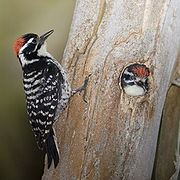
Nuttall's Woodpecker
Encyclopedia
Nuttall's Woodpecker, Picoides nuttallii, is a species of woodpecker
named after naturalist Thomas Nuttall
in 1843. They are found in oak woodlands of California and are similar to the Ladder-backed Woodpecker
(Picoides scalaris) in terms of genetics and in appearance.
(Picoides scalaris) of Arizona, New Mexico, Texas and Mexico. The Nuttall's Woodpecker likely evolved via allopatric speciation
when the two species were separated into smaller ranges by dry climate during the Pleistocene glaciation. Hybrids of the two species exist but are rare.
Birds are not considered globally threatened although the range is restricted to the California endemic bird area. Fairly common in California with a total world population estimated at over 100 000 individuals (density of about 20 birds per square kilometer in San Bernardino County). Surveys suggest no obvious population trends.
Call note – Used between mated pairs to communicate their location to each other.
Double Call – Same function as Call note can but also be used as a low threat alarm call.
Rattle call – Used to establish territories when feeding
Kweek Call – Call used between sexes mainly by female prior to copulation.
Both sexes drum. Rolls are relatively long, averaging over one second.

Woodpecker
Woodpeckers are near passerine birds of the order Piciformes. They are one subfamily in the family Picidae, which also includes the piculets and wrynecks. They are found worldwide and include about 180 species....
named after naturalist Thomas Nuttall
Thomas Nuttall
Thomas Nuttall was an English botanist and zoologist, who lived and worked in America from 1808 until 1841....
in 1843. They are found in oak woodlands of California and are similar to the Ladder-backed Woodpecker
Ladder-backed Woodpecker
The Ladder-backed Woodpecker is a North American woodpecker.-Range and habitat:The Ladder-backed Woodpecker is fairly common in dry brushy areas and thickets and has a rather large range...
(Picoides scalaris) in terms of genetics and in appearance.
Description
Nuttall’s Woodpecker has black wings and tail feathers with white barring. On the ventral surface, colour is white with black spots and barring. It has a black forehead with white streaks on the sides and an unbarred black region at the top of the back. Adult males have a distinguishable red crown which females do not. However, this physical feature is present in the juvenile of both sexes. They have zygodactyl feet and stiff tail feathers which allows them to maintain a vertical position on trees; typical of woodpeckers. The mass of Nuttall’s Woodpecker ranges from 30 to 45 g with a body length of 16 to 18 cm.Taxonomy
The Nuttall’s Woodpecker is closely related to the Ladder-backed WoodpeckerLadder-backed Woodpecker
The Ladder-backed Woodpecker is a North American woodpecker.-Range and habitat:The Ladder-backed Woodpecker is fairly common in dry brushy areas and thickets and has a rather large range...
(Picoides scalaris) of Arizona, New Mexico, Texas and Mexico. The Nuttall's Woodpecker likely evolved via allopatric speciation
Allopatric speciation
Allopatric speciation or geographic speciation is speciation that occurs when biological populations of the same species become isolated due to geographical changes such as mountain building or social changes such as emigration...
when the two species were separated into smaller ranges by dry climate during the Pleistocene glaciation. Hybrids of the two species exist but are rare.
Habitat and Distribution
Nuttall’s Woodpeckers are a non-migratory species with a geographic range that is confined to northern California extending south towards the northwest region of Baja California, Mexico. Their preferred habitat is arid to mesic woodlands. In particular, these woodpeckers prefer oak woodlands, although they also occur in riparian sites and chaparral in the most southern parts of its range because of the decrease in oak abundance. Individuals are found from sea level to 1250 m, rarely to 2000 m.Birds are not considered globally threatened although the range is restricted to the California endemic bird area. Fairly common in California with a total world population estimated at over 100 000 individuals (density of about 20 birds per square kilometer in San Bernardino County). Surveys suggest no obvious population trends.
Vocalizations
Vocalizations performed by Nuttall’s Woodpecker are considered to be not of any harmonic. Some vocalizations that have been described include:Call note – Used between mated pairs to communicate their location to each other.
Double Call – Same function as Call note can but also be used as a low threat alarm call.
Rattle call – Used to establish territories when feeding
Kweek Call – Call used between sexes mainly by female prior to copulation.
Both sexes drum. Rolls are relatively long, averaging over one second.
Diet
The diet of Nuttall’s Woodpeckers consists primarily of insects which are found on oaks. Common prey items include larvae of wood borers, click beetles, and ants but are also known to consume a variety of berry seeds. It has been observed that Nuttall’s Woodpecker feed on sap from sap holes created by Red-breasted Sapsuckers (Sphyrapicus ruber) in birch and willow. Foraging techniques used most often by Nuttall’s Woodpecker are tapping and probing into crevices of the tree to locate prey.Reproduction
Pair bonding occurs in late January to March with egg-laying mostly in April and May. Nuttall’s Woodpeckers are socially monogamous and show displays of bi-parental care. New nests are excavated each year by males inside cavities of dead trees such as willow, oak, and alder. Clutch sizes range from 3 to 6 eggs with the male partner incubating the eggs at night and the female during the day. Incubation period can be up to 14 days. Fledglings are able to leave the nest after 15 days post hatch with parental care continuing for 14 days after that.
External links
- Nuttall's Woodpecker, a bibliographic resource
- Nuttall's Woodpecker videos on the Internet Bird Collection
- Nuttall's Woodpecker photo gallery VIREO

